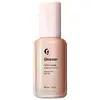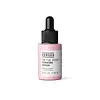What's inside
What's inside
 Key Ingredients
Key Ingredients

 Benefits
Benefits

 Concerns
Concerns

 Ingredients Side-by-side
Ingredients Side-by-side

Water
Skin ConditioningGlycerin
HumectantSqualane
EmollientIsoamyl Laurate
EmollientPolyglyceryl-3 Polyricinoleate
EmulsifyingButylene Glycol
HumectantSimmondsia Chinensis Seed Oil
EmollientPropanediol
SolventIsohexadecane
Emollient1,2-Hexanediol
Skin ConditioningOenothera Biennis Oil
EmollientOlive Oil Polyglyceryl-6 Esters
EmollientVitis Vinifera Seed Oil
EmollientRosa Canina Fruit Oil
EmollientPolyglyceryl-6 Pentaoleate
EmulsifyingSodium Hyaluronate
HumectantTocopheryl Acetate
AntioxidantEvodia Rutaecarpa Fruit Extract
Skin ConditioningRosmarinus Officinalis Leaf Oil
MaskingRicinus Communis Seed Oil
MaskingHydrogenated Castor Oil
EmollientHydroxyacetophenone
AntioxidantSodium Chloride
MaskingDisteardimonium Hectorite
StabilisingPropylene Carbonate
SolventTin Oxide
AbrasiveMica
Cosmetic ColorantCI 77891
Cosmetic ColorantCI 77491
Cosmetic ColorantWater, Glycerin, Squalane, Isoamyl Laurate, Polyglyceryl-3 Polyricinoleate, Butylene Glycol, Simmondsia Chinensis Seed Oil, Propanediol, Isohexadecane, 1,2-Hexanediol, Oenothera Biennis Oil, Olive Oil Polyglyceryl-6 Esters, Vitis Vinifera Seed Oil, Rosa Canina Fruit Oil, Polyglyceryl-6 Pentaoleate, Sodium Hyaluronate, Tocopheryl Acetate, Evodia Rutaecarpa Fruit Extract, Rosmarinus Officinalis Leaf Oil, Ricinus Communis Seed Oil, Hydrogenated Castor Oil, Hydroxyacetophenone, Sodium Chloride, Disteardimonium Hectorite, Propylene Carbonate, Tin Oxide, Mica, CI 77891, CI 77491
Water
Skin ConditioningPropylene Glycol
HumectantGlycerin
HumectantPropanediol
SolventButylene Glycol
HumectantResveratrol
AntioxidantPalmitoyl Tripeptide-1
Skin ConditioningPalmitoyl Tetrapeptide-7
Skin ConditioningRetinyl Palmitate
Skin ConditioningTocopheryl Acetate
AntioxidantTocopherol
AntioxidantSodium Hyaluronate
HumectantCitric Acid
BufferingPhenoxyethanol
PreservativePEG-40 Hydrogenated Castor Oil
EmulsifyingPolyacrylate Crosspolymer-6
Emulsion StabilisingSodium Ascorbyl Phosphate
AntioxidantXanthan Gum
EmulsifyingTrisodium Ethylenediamine Disuccinate
Ceramide AP
Skin Conditioning1,2-Hexanediol
Skin ConditioningCarbomer
Emulsion StabilisingSodium Metabisulfite
AntioxidantPolysorbate 20
EmulsifyingSodium Lactate
BufferingWater, Propylene Glycol, Glycerin, Propanediol, Butylene Glycol, Resveratrol, Palmitoyl Tripeptide-1, Palmitoyl Tetrapeptide-7, Retinyl Palmitate, Tocopheryl Acetate, Tocopherol, Sodium Hyaluronate, Citric Acid, Phenoxyethanol, PEG-40 Hydrogenated Castor Oil, Polyacrylate Crosspolymer-6, Sodium Ascorbyl Phosphate, Xanthan Gum, Trisodium Ethylenediamine Disuccinate, Ceramide AP, 1,2-Hexanediol, Carbomer, Sodium Metabisulfite, Polysorbate 20, Sodium Lactate
 Reviews
Reviews

Ingredients Explained
These ingredients are found in both products.
Ingredients higher up in an ingredient list are typically present in a larger amount.
1,2-Hexanediol is a synthetic liquid and another multi-functional powerhouse.
It is a:
- Humectant, drawing moisture into the skin
- Emollient, helping to soften skin
- Solvent, dispersing and stabilizing formulas
- Preservative booster, enhancing the antimicrobial activity of other preservatives
Butylene Glycol (or BG) is used within cosmetic products for a few different reasons:
Overall, Butylene Glycol is a safe and well-rounded ingredient that works well with other ingredients.
Though this ingredient works well with most skin types, some people with sensitive skin may experience a reaction such as allergic rashes, closed comedones, or itchiness.
Learn more about Butylene GlycolGlycerin is already naturally found in your skin. It helps moisturize and protect your skin.
A study from 2016 found glycerin to be more effective as a humectant than AHAs and hyaluronic acid.
As a humectant, it helps the skin stay hydrated by pulling moisture to your skin. The low molecular weight of glycerin allows it to pull moisture into the deeper layers of your skin.
Hydrated skin improves your skin barrier; Your skin barrier helps protect against irritants and bacteria.
Glycerin has also been found to have antimicrobial and antiviral properties. Due to these properties, glycerin is often used in wound and burn treatments.
In cosmetics, glycerin is usually derived from plants such as soybean or palm. However, it can also be sourced from animals, such as tallow or animal fat.
This ingredient is organic, colorless, odorless, and non-toxic.
Glycerin is the name for this ingredient in American English. British English uses Glycerol/Glycerine.
Learn more about GlycerinPropanediol is an all-star ingredient. It softens, hydrates, and smooths the skin.
It’s often used to:
Propanediol is not likely to cause sensitivity and considered safe to use. It is derived from corn or petroleum with a clear color and no scent.
Learn more about PropanediolSodium Hyaluronate is hyaluronic acid's salt form. It is commonly derived from the sodium salt of hyaluronic acid.
Like hyaluronic acid, it is great at holding water and acts as a humectant. This makes it a great skin hydrating ingredient.
Sodium Hyaluronate is naturally occurring in our bodies and is mostly found in eye fluid and joints.
These are some other common types of Hyaluronic Acid:
Learn more about Sodium HyaluronateTocopheryl Acetate is AKA Vitamin E. It is an antioxidant and protects your skin from free radicals. Free radicals damage the skin by breaking down collagen.
One study found using Tocopheryl Acetate with Vitamin C decreased the number of sunburned cells.
Tocopheryl Acetate is commonly found in both skincare and dietary supplements.
Learn more about Tocopheryl AcetateWater. It's the most common cosmetic ingredient of all. You'll usually see it at the top of ingredient lists, meaning that it makes up the largest part of the product.
So why is it so popular? Water most often acts as a solvent - this means that it helps dissolve other ingredients into the formulation.
You'll also recognize water as that liquid we all need to stay alive. If you see this, drink a glass of water. Stay hydrated!
Learn more about Water